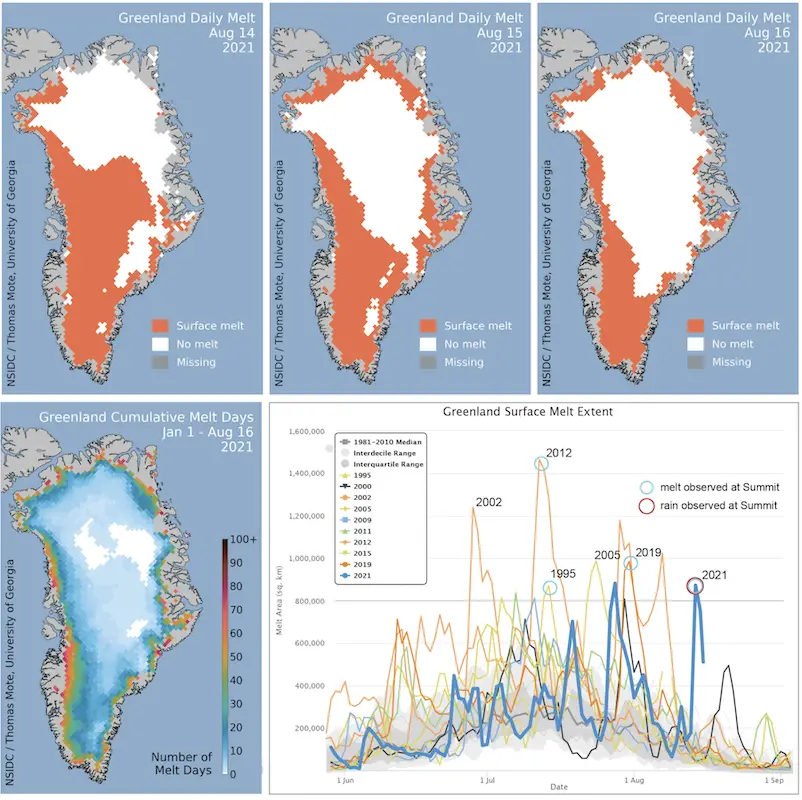When last we checked in on Greenland things weren’t going particularly well. The island had seen a massive melt off that saw more than 18 billion tons of ice disappear in a single day. So much ice disappeared in fact that it was enough to cover the entire state of Florida in 2 inches (5 cm) of water.
Fast forward a few weeks and things aren’t exactly getting much better. In yet another sign that climate change is here and having a lasting impact on our planet, it actually rained at the Greenland Summit Station. What’s wrong with that you ask? Well for starters, this has never happened before in recorded history.

Changing Weather at the Summit
Operated by the U.S. National Science Foundation, the Summit Station (or Summit Camp as it is also known) is located in central Greenland at an altitude of 10,551 feet (3216 meters). This puts it in a region that is almost perpetually below freezing, even at the height of summer in the Northern Hemisphere. Conditions are so chilly at the summit that Saturday, August 14, marked just the third time that temperatures rose above 32ºF/0ºC in the past decade. It is also the latest date in the year that such a temperature spike occurred as well.
The balmy temperatures—at least by Greenland standards—weren’t the most concerning bit of weather news however. The island, which is an autonomous territory belonging to Denmark, actually saw substantial rainfall across the region. It is estimated that seven billion tons of ran fell there on August 14 and 15 alone, causing even more melting.
The rain was so widespread that it even occurred at the Greenland Summit Station, which has been in operation since April of 1989. In the 30+ years since it was first established, researchers have never witnessed rain at that location. Furthermore, historical data derived from ice cores that were taken at the station show no indication of rain occurring in the past either.

Melt Offs Increasing in Frequency
According to the National Snow & Ice Data Center, the mid-August melting event brought on by the rainfall impacted 337,000 square miles (872,000 sq. km), stretching from the southeast coast to the Summit region. This is just the second time in history that two major melt offs have occurred in the same year, with 2012 also seeing a significant loss of ice.
Since the Summit Station has been in operation, it has recorded massive melt off events taking place in four different years. The first of those events occurred in 1995, with subsequent melt offs taking place in 2012, 2019, and now 2021. Ice core data shows that the previous largest melting event took place back in the late 1800s.
This year’s loss of ice is cause for concern for several reason. The first is that it follows so closely on the heels of the 2019 melt off, which means there has been little time for the ice sheets to rebuild and recover. The second reason is due to the fact that two separate melt offs have occurred in the same year, with the latest coming so late in the summer. While much of the Northern Hemisphere is still basking in the warmth of August, Greenland has typically turned the corner and begun cooling off by now.
What Does This Mean for the Future?
So what does rainfall and melting ice in Greenland mean for the health of the planet? As noted, last month, as this ice turns to water it is running off into the North Atlantic and Arctic Oceans. That means those two bodies of water have slowly started to rise. Right now, that change in depth is mostly imperceptible, but over time coastal communities will begin to feel the impact.
Conditions are likely to get worse too. Climatologists are predicting that rain will be a common occurrence in the Arctic moving forward, hastening the loss of the ice caps and causing ocean levels to rise. This will reshape the world’s coastlines in the decades to come, endangering cities and towns in the process. Thanks to the loss of ice in Greenland and the Antarctic, sea levels are already rising faster than they have at any time in the past 3000 years.
Couple all of this news with the U.N.’s recent climate report and things certainly look bad for the planet. How we adapt to these changing conditions will determine the future of human beings on Earth. Hopefully we can act now to slow the changes we’re now experiencing and perhaps roll back our environmental impact in the future.
- Gear Review: The Xero Scrambler Mid is an Ultralight Hiking Shoe for Spring - March 1, 2023
- Gear Review: Yeti Roadie 48 Wheeled Cooler - August 18, 2022
- Kristin Harila Continues Pursuit of 8000-Meter Speed Record - August 16, 2022
